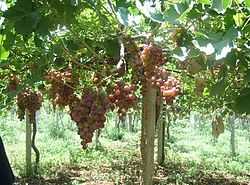Hauran
| Hauran Plateau | |
|---|---|
| سهل حوران | |
 The village of Johfiyeh in the Jordanian side of the plateau | |
| Location | |
 | |
| Location | Syria/Jordan |

Hauran, (Arabic: حوران / ALA-LC: Ḥawrān), also spelled Hawran or Houran, is a volcanic plateau, a geographic area and a people located in southwestern Syria and extending into the northwestern corner of Jordan. It gets its name from the Aramaic Hawran, meaning "cave land." In geographic and geomorphic terms, its boundaries generally extends from near Damascus and Mt. Hermon in the north to the Ajloun mountains of Jordan in the south. The area includes the Golan Heights on the west and is bounded there by the Jordan Rift Valley; it also includes Jabal ad-Duruz in the east and is bounded there by more arid steppe and desert terrains. The Yarmouk River drains much of the Hauran to the west and is the largest tributary of the Jordan River.
The volcanic soils of Hauran make it one of the most fertile regions in Syria; it produces considerable wheat and is particularly famous for its vineyards. The region receives above-average annual precipitation but has few rivers. Hauran relies mainly on annual snow and rain during winter and spring and many of the ancient sites contain cisterns and water storage facilities to better utilize the seasonal rainfall. The area is unlike other historical fertile areas of Syria, (the Orontes and the Euphrates river valleys), which rely on controlled irrigation systems for their farming productivity. Since the mid-1980s, Syria has built a considerable number of seasonal storage dams within the headwaters of the Yarmouk River drainage basin.[1]
History
The plains of Houran appear to have been initially inhabited by small bands of hunters and gatherers. By circa 12,000 BC, microliths and bone tools were becoming part of daily lifestyle[citation needed]. It is thought that the development of farming around 10,000 BC triggered an agricultural revolution that changed human history and paved the way for the appearance of ancient civilizations after millennia of hunting and gathering in small groups. By this time Natufians settled in Taiyiba in southern Houran, and southwest of Houran in Tabqat Fahl and in the Golan Heights to the west in Nhal ‘En Gev-II as well as all over Canaan.
To their east, circa 8,300 BC wheat was domesticated and their neighbors to the west in Canaan and to the East in Mesopotamia started living in oval houses. Between 8,000 and 7,000 BC, people of Hauran were eating mostly hunted gazelles and foxes. Between 7000 and 6000 BC their daily food was mostly domesticated animals (sheep, goat, pig, and cattle) and domesticated cereals. By the 4th millennium BC (4,000 BC to 3,000 BC) there were many Chalcolithic settlements in the valley of the Yarmouk river.
The Hauran is mentioned in the Bible (Ezekiel 47:16-18) describing the boundary area of the Israelite Kingdom at the time.[citation needed] Centuries later, the Ancient Greeks and Romans referred to the area as Auranitis, and it marked the traditional eastern border of Roman Syria; this is evidenced by the well-preserved Roman ruins in the cities of Bosra and Shahba. At the time, the Hauran also included the northern cities of the Decapolis.
19th-century Swiss traveller Johann Ludwig Burckhardt noted his observation of people from the region:
My companions intending to leave Damascus very early the next morning, I quitted my lodgings in the evening, and went with them to sleep in a small Khan in the suburb of Damascus, at which the Haouaerne, or people of Hauran, generally alight.[2]
Today, the Hauran is not a distinct political entity, but encompasses the Syrian governorates of Quneitra, As Suwayda, and Daraa, and the Jordanian governorates of Irbid, Ajloun and Jerash, as well as the western part of Mafraq Governorate. However, the name is used colloquially by both the inhabitants of the region (Hauranis) and outsiders, to refer to the area and its people.
Major cities
| | |
|---|---|
| Daraa | Ar Ramtha |
| Busra | Irbid |
| Quneitra | Ajloun |
| Suwaida | Jerash |
Villages
- Aidoon
- Akaider
- Al-Sanamayn
- AlQurayya
- Shajara, Jordan
- Abtaa
- Ashaykh Maskin
- AlJiza
- AlYadudah
- Bassir
- Busra al-Harir
- Buwaidha
- Jileen
- Johfiyeh
- Huwwarah
- Izra'
- Khabab
- Da'el
- Nuaymah
- Sal
- Sarih
- Shajara, Syria
- Tubna
- Deir al-Bukht
- Tafas
- Muzayrib
- Ajami
- Zeizun
- Tell Shihab
- Qarfa
- Namar
- Saham al-Jawlan
- Nafia
- Lemseifreh
- Umm Walad
- Lemtaeyeh
- Kharab al-Shahem
- Lihrak
- Othman
- Gaittah
- Nawa
- Jasim
Roman bridges
Famous figures from Houran
- Ibn Qayyim Al-Jawziyya
- Farid al-Atrash
- Asmahan
- Fahd Ballan
- Mahmoud Zuabi
- Mustafa Wahbi
Gallery
-

Dar (House of) Saleem Muhammad -el Hamad- el Gharaibeh-Irbid-Jordan
-

Dar Abu Habis (Dhaifallah el Mahmoud el Gharaibeh)-Irbid-Jordan
-

Dar Abu Ghaleb-Irbid-Jordan
-

Dar Qasim Tanash Courtesy of Ahmed Abdallah Jameel Gharaibeh-Irbid-Jordan
References
- ↑ http://www.transboundarywaters.orst.edu/projects/casestudies/jordan_river.html Jordan River: Johnston negotiations, 1953-55; Yarmuk mediations, 1980's
- ↑ Travels in Syria and the Holy Land: Journal of an Excursion into the Hauran in the Autumn and Winter of 1810